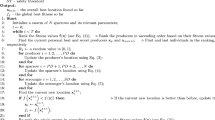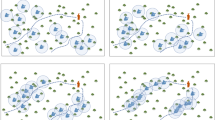Abstract
Multi-modal optimization algorithms are one of the most challenging issues in the field of optimization. Most real-world problems have more than one solution; therefore, the potential role of multi-modal optimization algorithms is rather significant. Multi-modal problems consider several global and local optima. Therefore, during the search process, most of the points should be detected by the algorithm. The forest optimization algorithm has been recently introduced as a new evolutionary algorithm with the capability of solving unimodal problems. This paper presents the multi-modal forest optimization algorithm (MMFOA), which is constructed by applying a clustering technique, based on niching methods, to the unimodal forest optimization algorithm. The MMFOA operates by dividing the population of the forest into subpopulations to locate existing local and global optima. Subpopulations are generated by the Basic Sequential Algorithmic Scheme with a radius neighborhood. As population size is self-adaptive in MMFOA, population size can be increased in functions with too many local and global optima. The proposed algorithm is evaluated by a set of multi-modal benchmark functions. The experiment results show that not only is the population size low, but also that the convergence speed is high, and that the algorithm is efficient in solving multi-modal problems.











Similar content being viewed by others
References
Ghaemi M, Feizi-Derakhshi M-R (2014) Forest optimization algorithm. Expert Syst Appl 41(15):6676–6687
Hastings CA, Norton SM, Roy S (2002) New algorithms for processing and peak detection in liquid chromatography/mass spectrometry data. Rapid Commun Mass Spectrom 16(5):462–467
Peters S, Vivó-Truyols G, Marriott PJ, Schoenmakers PJ (2007) Development of an algorithm for peak detection in comprehensive two-dimensional chromatography. J Chromatogr A 1156(1–2):14–24
Horowitz SL (1975) A syntactic algorithm for peak detection in waveforms with applications to cardiography. Commun ACM 18(5):281–285
Jacobson A (2001) Auto-threshold peak detection in physiological signals. In: Engineering in Medicine and Biology Society, 2001. In: Proceedings of the 23rd annual international conference of the IEEE. IEEE, pp 2194–2195
Contributors W (2018) Multimodal. Wikipedia, The Free Encyclopedia. https://en.wikipedia.org/w/index.php?title=Multimodal&oldid=850078958
Anam S (2017) Multimodal optimization by using hybrid of artificial bee colony algorithm and BFGS algorithm. In: Journal of physics: conference series, vol 1. IOP Publishing, p 012068
Cuevas E, Sención-Echauri F, Zaldivar D, Pérez-Cisneros M (2012) Multi-circle detection on images using artificial bee colony (ABC) optimization. Soft Comput 16(2):281–296
Tan KS, Isa NAM (2011) Color image segmentation using histogram thresholding–Fuzzy C-means hybrid approach. Pattern Recognit 44(1):1–15
Kurugollu F, Sankur B, Harmanci AE (2001) Color image segmentation using histogram multithresholding and fusion. Image Vis Comput 19(13):915–928
Gandomi AH, Yang X-S, Alavi AH (2013) Cuckoo search algorithm: a metaheuristic approach to solve structural optimization problems. Eng Comput 29(1):17–35
Brits R, Engelbrecht AP, Van den Bergh F (2002) A niching particle swarm optimizer. In: Proceedings of the 4th Asia-Pacific conference on simulated evolution and learning. Orchid Country Club, Singapore, pp 692–696
Seo J-H, Im C-H, Heo C-G, Kim J-K, Jung H-K, Lee C-G (2006) Multimodal function optimization based on particle swarm optimization. IEEE Trans Magn 42(4):1095–1098
Qu B-Y, Suganthan PN, Das S (2013) A distance-based locally informed particle swarm model for multimodal optimization. IEEE Trans Evol Comput 17(3):387–402
Li X (2010) Niching without niching parameters: particle swarm optimization using a ring topology. IEEE Trans Evol Comput 14(1):150–169
Yin X, Germay N (1993) A fast genetic algorithm with sharing scheme using cluster analysis methods in multimodal function optimization. In: Artificial neural nets and genetic algorithms, pp 450–457
Miller BL, Shaw MJ (1996) Genetic algorithms with dynamic niche sharing for multimodal function optimization. In: Proceedings of IEEE international conference on evolutionary computation, 1996. IEEE, pp 786–791
Goldberg DE, Richardson J (1987) Genetic algorithms with sharing for multimodal function optimization. In: Genetic algorithms and their applications: Proceedings of the second international conference on genetic algorithms. Lawrence Erlbaum, Hillsdale, pp 41–49
Ueno A, Hagita N, Takubo T (2016) A niching genetic algorithm including an inbreeding mechanism for multimodal problems. In: Genetic and evolutionary computing. Springer, New York, pp 71–80
Yazdani S, Nezamabadi-pour H, Kamyab S (2014) A gravitational search algorithm for multimodal optimization. Swarm Evol Comput 14:1–14
Rahkar-Farshi T, Behjat-Jamal S (2016) A multimodal firefly optimization algorithm based on coulomb’s law. Int J Adv Comput Sci Appl 7(5):134–141
Talebi H, Nikoo H, Mirzaei A, Boushehri SAS (2014) Niching imperialistic competitive algorithm. In: 13th International conference on parallel problem solving from nature
Liu Y, Ling X, Liang Y, Lv M, Liu G (2012) Artificial bee colony (ABC) algorithm for multimodal function optimization. Adv Sci Lett 11(1):503–506
Kamyab S, Eftekhari M (2013) Using a self-adaptive neighborhood scheme with crowding replacement memory in genetic algorithm for multimodal optimization. Swarm Evol Comput 12:1–17
Sareni B, Krahenbuhl L (1998) Fitness sharing and niching methods revisited. IEEE Trans Evol Comput 2(3):97–106
Goldberg DE, Wang L (1997) Adaptive niching via coevolutionary sharing. Genet Algor Evol Strat Eng Comput Sci 21–38
Lin C-Y, Wu W-H (2002) Niche identification techniques in multimodal genetic search with sharing scheme. Adv Eng Softw 33(11):779–791
De Jong KA (1975) Analysis of the behavior of a class of genetic adaptive systems
Mahfoud SW (1992) Crowding and preselection revisited. Urbana 51:61801
Li M, Lin D, Kou J (2012) A hybrid niching PSO enhanced with recombination-replacement crowding strategy for multimodal function optimization. Appl Soft Comput 12(3):975–987
Pétrowski A (1996) A clearing procedure as a niching method for genetic algorithms. In: Proceedings of IEEE international conference on evolutionary computation, 1996. IEEE, pp 798–803
Sacco WF, Henderson N, Rios-Coelho AC (2014) Topographical clearing differential evolution: A new method to solve multimodal optimization problems. Prog Nucl Energy 71:269–278
Singh G, Deb K (2006) Comparison of multi-modal optimization algorithms based on evolutionary algorithms. In: Proceedings of the 8th annual conference on Genetic and evolutionary computation, 2006. ACM, pp 1305–1312
Streichert F, Stein G, Ulmer H, Zell A (2003) A clustering based niching ea for multimodal search spaces. In: International conference on artificial evolution (Evolution Artificielle), 2003. Springer, New York, pp 293–304
Yu E, Suganthan PN (2010) Ensemble of niching algorithms. Inf Sci 180(15):2815–2833
Li J-P, Balazs ME, Parks GT, Clarkson PJ (2002) A species conserving genetic algorithm for multimodal function optimization. Evol Comput 10(3):207–234
Li JP, Wood AS (2009) An adaptive species conservation genetic algorithm for multimodal optimization. Int J Numer Meth Eng 79(13):1633–1661
Li X (2007) A multimodal particle swarm optimizer based on fitness Euclidean-distance ratio. In: Proceedings of the 9th annual conference on genetic and evolutionary computation, 2007. ACM, pp 78–85
Barrera J, Coello CAC (2009) A particle swarm optimization method for multimodal optimization based on electrostatic interaction. In: MICAI, 2009. Springer, New York, pp 622–632
Qu B-Y, Liang JJ, Suganthan PN (2012) Niching particle swarm optimization with local search for multi-modal optimization. Inf Sci 197:131–143
Takahashi O, Kimura S, Kobayashi S (2002) An adaptive neighboring search using crossover-like mutation for deceptive multimodal function optimization. Trans Jpn Soc Artif Intell 16:175–184
Nagata Y (2009) An adaptive niching genetic algorithm using a niche size equalization mechanism. Trans Jpn Soc Artif Intell 24:92–103
Wolpert DH, Macready WG (1997) No free lunch theorems for optimization. IEEE Trans Evol Comput 1(1):67–82
Li X, Engelbrecht A, Epitropakis MG (2013) Benchmark functions for CEC’2013 special session and competition on niching methods for multimodal function optimization. RMIT University, Evolutionary Computation and Machine Learning Group, Australia, Tech Rep
Liang J, Runarsson TP, Mezura-Montes E, Clerc M, Suganthan PN, Coello CC, Deb K (2006) Problem definitions and evaluation criteria for the CEC 2006 special session on constrained real-parameter optimization. J Appl Mech 41(8):8–31
Shir OM, Emmerich M, Bäck T (2010) Adaptive niche radii and niche shapes approaches for niching with the CMA-ES. Evol Comput 18(1):97–126. https://doi.org/10.1162/evco.2010.18.1.18104
Author information
Authors and Affiliations
Corresponding author
Ethics declarations
Conflict of interest
The authors declare that they have no conflict of interest.
Additional information
Publisher's Note
Springer Nature remains neutral with regard to jurisdictional claims in published maps and institutional affiliations.
Rights and permissions
About this article
Cite this article
Orujpour, M., Feizi-Derakhshi, MR. & Rahkar-Farshi, T. Multi-modal forest optimization algorithm. Neural Comput & Applic 32, 6159–6173 (2020). https://doi.org/10.1007/s00521-019-04113-z
Received:
Accepted:
Published:
Issue Date:
DOI: https://doi.org/10.1007/s00521-019-04113-z




